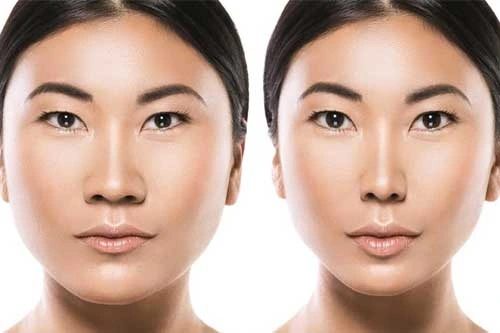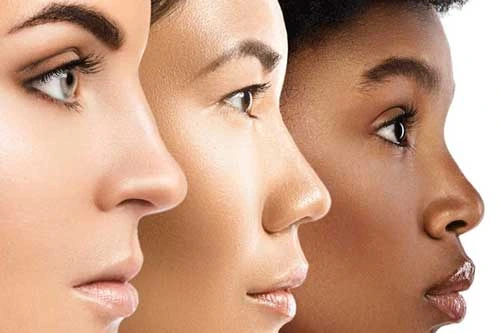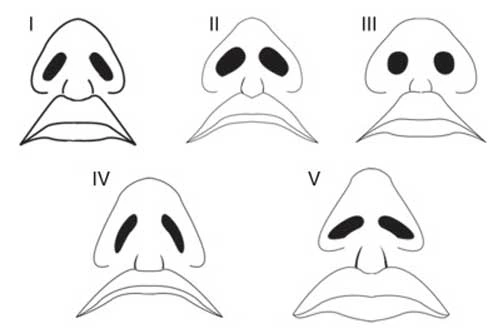The human face is a canvas of unique features, each reflecting the rich tapestry of ethnic diversity. Among these features, the nose holds particular significance, as its shape often showcases distinctive traits associated with different ethnic backgrounds. In this article, we embark on a fascinating journey, delving into the various nose shapes found across different ethnicities, from the elegant contours of European noses to the beautifully diverse array seen in African, Asian, and Middle Eastern populations.
White People Nose: European Noses Types
Within the realm of European noses, a captivating tapestry of shapes and proportions unfolds, mirroring the rich diversity encapsulated within this ethnic group. The ‘Greek’ or ‘straight’ nose stands as a testament to harmonious proportions, featuring an elegantly straight bridge and a delicately refined tip. This nose exudes a timeless sense of grace and balance, contributing to an overall aura of classic beauty.
In contrast, the ‘Roman’ nose takes center stage with its commanding presence. Characterized by a more pronounced bridge, it bestows an air of strength and distinctive character upon its bearer. This nose shape, often celebrated for its bold contours, speaks to a heritage of resilience and fortitude, leaving an indelible mark on the facial landscape.
Venturing further into the spectrum, we encounter the enchanting ‘snub’ nose, a hallmark often associated with Northern European lineage. This endearing feature boasts a slightly upturned tip, lending an infectious youthful charm to the countenance. It is a nose that radiates an evergreen spirit, infusing a touch of vivacity into the facial profile.
What sets European noses apart is their remarkable versatility. They serve as a canvas for both timeless elegance and distinct individuality. Each nose shape, be it the straight, the Roman, or the snub, encapsulates a unique narrative, weaving a tale of heritage, character, and enduring beauty. Together, they form a mosaic of diversity that celebrates the multifaceted nature of European ethnicity.
African Noses: Celebrating Diversity
Africa, with its myriad of cultures and ethnicities, boasts an astonishing array of nose shapes. From the ‘platyrrhine’ noses found in some West African populations, characterized by their broad base and flatter bridge, to the ‘leptorrhine’ noses seen in East Africa, which tend to be narrower and more elevated, the continent exemplifies the beauty of diversity. These nose shapes not only serve as a testament to the rich cultural heritage of Africa but also offer a fascinating glimpse into the adaptation of human anatomy to various environments.
Asian Noses: A Study in Grace
Asian noses, renowned for their graceful proportions, encompass a wide spectrum of shapes. The ‘button’ nose, often characterized by a small, rounded tip, is a prominent feature in many East Asian populations, conveying an endearing and youthful aesthetic. Conversely, the ‘high-bridged’ nose, more commonly found in Southeast Asia, imparts an air of sophistication and elegance. These variations in nose shape within the Asian ethnicity reflect the diverse cultural landscapes across the continent.
Middle Eastern Noses: Elegance and Heritage
The Middle Eastern region, with its vast expanse and diverse populations, is indeed a treasure trove of cultural richness and historical significance. One of the most fascinating aspects of this heritage is reflected in the distinctive nose shapes that have evolved over centuries. Among these, the ‘aquiline’ or ‘Roman’ nose takes center stage, serving as an emblem of strength, character, and an enduring connection to ancestral roots.
The ‘aquiline’ nose, with its gracefully curved bridge, is a prominent feature in many Middle Eastern populations. This elegant curvature gives the nose a distinctive profile, evoking a sense of regality and heritage. It is a testament to the intricate interplay between genetics, environment, and centuries-old cultural influences that have sculpted this unique feature.
In many Middle Eastern cultures, the ‘aquiline’ nose holds great significance. It is often revered as a symbol of pride, representing a lineage that has withstood the test of time. This nose shape is celebrated as a tangible link to ancestors, a physical embodiment of the enduring spirit and legacy of generations past. It stands as a reminder of the resilience, wisdom, and dignity that have been passed down through the ages.
Furthermore, the ‘aquiline’ nose is not merely a physical trait; it carries with it a sense of character and strength. Its prominence on the face imparts an air of confidence and authority. In many Middle Eastern societies, these qualities are highly esteemed, reflecting the values of honor, fortitude, and grace that have defined the region’s history.
As we appreciate the profound cultural tapestry of the Middle East, it is impossible to ignore the significance of the ‘aquiline’ nose. It serves as a visual narrative, telling stories of generations past and embodying the enduring legacy of a people. This unique nose shape stands as a bridge between the past, present, and future, reminding us of the depth and richness of Middle Eastern heritage.
Iranian Nose Shapes
The Iranian population is a mosaic of diverse ethnic groups, each contributing to the rich tapestry of the country’s cultural and historical heritage. Among the myriad facets of this diversity, the distinctive characteristics of Iranian nose shapes stand out as a testament to the unique beauty that spans across various ethnicities.
The Persian Influence
Persians, constituting a significant portion of Iran’s population, have had a profound impact on the country’s cultural identity. The Persian nose, characterized by its straight bridge and defined tip, is often considered the quintessential Iranian nose shape. This elegant and refined feature has become synonymous with classical Persian beauty standards.
The Azeri Aesthetic
The Azeri ethnic group, primarily residing in the northwest of Iran, brings its own distinctive nasal attributes to the tableau. The Azeri nose is often characterized by its slightly broader bridge and a gentle curve at the tip. This subtle variation adds a unique charm to the overall facial profile, reflecting the Azeri people’s cultural heritage.
The Kurdish Heritage
Kurdish Iranians, residing primarily in the western regions of Iran, possess their own captivating nose shapes. The Kurdish nose typically exhibits a straight bridge, often complemented by a delicately defined tip. This feature contributes to a harmonious and balanced facial appearance, symbolizing the resilience and grace of the Kurdish ethnic group.
Balochi Elegance
In the southeastern province of Sistan and Baluchestan, the Balochi ethnic group showcases its own distinct nose shapes. The Balochi nose is often characterized by a refined bridge and a gently curved tip. This feature exudes a sense of elegance and complements the broader facial features that are characteristic of the Balochi people.
The Caspian Contribution
Iran’s northern regions, along the Caspian Sea, are home to a diverse array of ethnicities, including Gilaks and Mazandaranis. The nose shapes of these communities are often characterized by their refined, straight bridges and subtly defined tips. These features contribute to an air of sophistication and reflect the unique beauty standards of the Caspian region.
Hispanic and Latino Noses: Fusion of Cultures
The Hispanic and Latino populations encompass a vibrant fusion of cultures, and this diversity is beautifully reflected in their nose shapes. From the ‘celestial’ nose, characterized by a graceful curvature and elegant bridge, to the ‘mesorrhine’ nose, which strikes a balance between width and projection, the variations are as diverse as the cultures themselves. These noses embody the rich tapestry of influences that have shaped the Hispanic and Latino heritage.
Ethnic Rhinoplasty
Rhinoplasty, often referred to as a “nose job,” is a surgical procedure that reshapes and enhances the nose. While it is a highly personal choice, rhinoplasty can also be a cultural and identity-affirming experience, especially for individuals seeking to maintain or enhance their ethnic features. Ethnic rhinoplasty is a specialized form of this procedure that celebrates the unique characteristics of different ethnic backgrounds. In this article, we will explore the nuances of ethnic rhinoplasty, highlighting its significance in preserving cultural identity while enhancing one’s natural beauty.
Embracing Diversity:
The beauty of ethnic rhinoplasty lies in its ability to honor and preserve the distinctive features that define different ethnicities. Rather than striving for a one-size-fits-all approach, skilled surgeons understand the importance of tailoring the procedure to each individual’s unique facial structure and cultural background. Whether it’s refining the contours of an African, Asian, Middle Eastern, or Latin American nose, the goal of ethnic rhinoplasty is to achieve harmony and balance while respecting the inherent beauty of each ethnic heritage.
Cultural Sensitivity in Practice:
Ethnic rhinoplasty requires a deep understanding of facial anatomy, as well as a genuine appreciation for the cultural significance of nose shape within different communities. Surgeons who specialize in this field undergo rigorous training to develop both technical expertise and cultural sensitivity. This ensures that the procedure not only enhances physical appearance but also empowers individuals to feel more connected to their heritage and confident in their own skin.
Preserving Identity:
One of the primary goals of ethnic rhinoplasty is to preserve the individual’s unique cultural identity while addressing specific aesthetic concerns. For example, a person of African descent may wish to refine their nose’s contours while still embracing the broad, elegant features that are characteristic of many African ethnicities. Similarly, someone of Asian heritage may seek to enhance the proportions of their nose while respecting the graceful lines that define Asian facial aesthetics. The artistry of ethnic rhinoplasty lies in striking the delicate balance between cultural preservation and individual enhancement.
Beyond Aesthetics:
Indeed, the significance of ethnic rhinoplasty transcends mere physical alteration. It carries with it a profound influence that ripples through various facets of an individual’s life. Beyond the refined contours and sculpted features, this transformative procedure holds the power to instill a profound sense of cultural affirmation.
For those who embark on this journey, ethnic rhinoplasty becomes a potent tool of self-empowerment. It serves as a medium through which individuals can align their external appearance with their intrinsic cultural identity. This alignment, in turn, becomes a source of immense pride and confidence, permeating every interaction and endeavor.
Stepping out into the world post-rhinoplasty, individuals do so with a newfound assurance, secure in the knowledge that their appearance now harmoniously mirrors their personal preferences and, most importantly, their rich heritage. This fusion of aesthetic preference and cultural legacy forms a powerful synthesis, one that reinforces a profound sense of belonging and self-assuredness.
The impact of ethnic rhinoplasty, then, radiates far beyond the confines of physical transformation. It is a celebration of diversity, a testament to the resilience of cultural identity, and a catalyst for enhanced confidence and self-assurance. With every glance in the mirror, individuals are met not only with an image that resonates with their personal ideals but also with a reflection of the vibrant tapestry of their cultural heritage.
Choosing a Skilled Surgeon
When considering ethnic rhinoplasty, it is crucial to select a surgeon with extensive experience and expertise in this specialized field. A skilled surgeon not only possesses technical proficiency but also understands the cultural nuances associated with different ethnic backgrounds. They approach each procedure with sensitivity and an artistic eye, ensuring that the results not only enhance physical appearance but also honor the individual’s unique heritage.
Do you want to have your nose job in Antaya , Contact Medgol.
Customized Approach:
No two ethnic rhinoplasty procedures are alike. A key aspect of this surgical technique is the customized approach taken for each patient. Surgeons carefully assess the patient’s facial anatomy, considering factors such as nose shape, skin type, and overall facial proportions. They work collaboratively with the patient to understand their specific goals and desires, ensuring that the final result is a harmonious blend of cultural preservation and individual enhancement.
Post-Surgery Recovery and Care:
Recovery after ethnic rhinoplasty is a crucial phase of the process. Patients are advised to follow their surgeon’s post-operative instructions diligently. This may include recommendations for pain management, swelling reduction techniques, and avoiding certain activities that could strain the healing process. Regular follow-up appointments allow the surgeon to monitor progress and provide additional guidance for optimal healing.
Emotional Impact:
The emotional impact of ethnic rhinoplasty should not be underestimated. For many individuals, this procedure is a transformative experience that goes beyond physical changes. It fosters a sense of self-assurance and pride, allowing them to fully embrace their cultural identity. The newfound confidence radiates outward, positively influencing various aspects of their personal and professional lives.
Cultural Sensitivity in Patient Care:
Ethnic rhinoplasty requires not only surgical skill but also a profound understanding of cultural diversity. Surgeons who specialize in this field take great care to ensure that their patients feel heard, understood, and respected. They create a supportive environment where patients can openly discuss their desires and concerns, knowing that their cultural background will be valued throughout the process.
Empowerment Through Ethnic Rhinoplasty:
In the realm of aesthetic surgery, ethnic rhinoplasty stands as a testament to the power of celebrating diversity and individuality. It empowers individuals to take control of their appearance while honoring their cultural heritage. Through this procedure, patients emerge not only with enhanced physical features but also with a renewed sense of confidence and pride in who they are.
Conclusion
Ethnic rhinoplasty is a celebration of diversity, a testament to the beauty that arises from embracing and preserving individual and cultural identity. Through this specialized form of rhinoplasty, individuals can enhance their natural features while honoring the unique traits that define their ethnic background. By choosing surgeons who specialize in ethnic rhinoplasty, individuals embark on a journey of self-discovery and empowerment, ultimately emerging with a newfound sense of confidence and pride in their appearance.
The diversity of nose shapes across different ethnicities is a testament to the beauty of human variation. From the elegant contours of European noses to the rich heritage reflected in Middle Eastern profiles, each nose shape carries a unique narrative of culture, adaptation, and individuality. Embracing and celebrating this diversity allows us to appreciate the intricate tapestry that makes up the human experience. Remember, it is this very diversity that enriches our world and makes it a more beautiful and fascinating place.
FAQs
What is Ethnic Rhinoplasty?
Ethnic Rhinoplasty, also known as cultural rhinoplasty, is a specialized surgical procedure designed to enhance or refine the appearance of the nose while respecting and preserving the unique cultural characteristics of an individual. It takes into consideration the patient’s specific ethnic background, facial anatomy, and desired aesthetic goals to create natural and harmonious results.
Who is a Suitable Candidate for Ethnic Rhinoplasty?
Suitable candidates for Ethnic Rhinoplasty are individuals who wish to improve the appearance of their nose while maintaining their cultural identity. They should be in good overall health, have realistic expectations, and be open to a collaborative discussion with the surgeon regarding their desired outcomes. A comprehensive consultation with an experienced surgeon will help determine candidacy.
What are the Common Goals of Ethnic Rhinoplasty?
The goals of Ethnic Rhinoplasty vary based on the individual’s preferences and cultural background. Common objectives may include refining the nasal tip, adjusting nostril width, improving nasal bridge proportions, and addressing any functional concerns. The ultimate aim is to achieve balanced and harmonious facial features that align with the patient’s heritage.
How Long is the Recovery Period for Ethnic Rhinoplasty?
The recovery period for Ethnic Rhinoplasty typically spans several weeks. Initially, patients may experience some swelling, bruising, and mild discomfort. Strenuous activities should be avoided during the early stages of recovery. Over time, the swelling will subside, and the final results will gradually become apparent. Close post-operative follow-up appointments with the surgeon are crucial for monitoring progress.
How Important is Cultural Sensitivity in Ethnic Rhinoplasty?
Cultural sensitivity is paramount in Ethnic Rhinoplasty. A skilled surgeon in this field should not only possess technical expertise but also a deep understanding of the diverse cultural backgrounds of their patients. They should respect and value the individual’s heritage, ensuring that the surgical outcome reflects a harmonious blend of aesthetic enhancement and cultural preservation.




